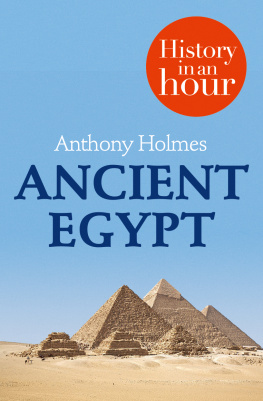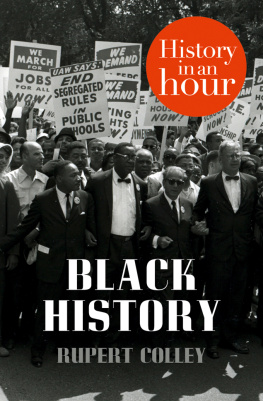Anthony Holmes - Ancient Egypt: History in an Hour
Here you can read online Anthony Holmes - Ancient Egypt: History in an Hour full text of the book (entire story) in english for free. Download pdf and epub, get meaning, cover and reviews about this ebook. year: 2011, publisher: HarperCollins UK, genre: Non-fiction. Description of the work, (preface) as well as reviews are available. Best literature library LitArk.com created for fans of good reading and offers a wide selection of genres:
Romance novel
Science fiction
Adventure
Detective
Science
History
Home and family
Prose
Art
Politics
Computer
Non-fiction
Religion
Business
Children
Humor
Choose a favorite category and find really read worthwhile books. Enjoy immersion in the world of imagination, feel the emotions of the characters or learn something new for yourself, make an fascinating discovery.
- Book:Ancient Egypt: History in an Hour
- Author:
- Publisher:HarperCollins UK
- Genre:
- Year:2011
- Rating:5 / 5
- Favourites:Add to favourites
- Your mark:
- 100
- 1
- 2
- 3
- 4
- 5
Ancient Egypt: History in an Hour: summary, description and annotation
We offer to read an annotation, description, summary or preface (depends on what the author of the book "Ancient Egypt: History in an Hour" wrote himself). If you haven't found the necessary information about the book — write in the comments, we will try to find it.
Ancient Egypt: History in an Hour — read online for free the complete book (whole text) full work
Below is the text of the book, divided by pages. System saving the place of the last page read, allows you to conveniently read the book "Ancient Egypt: History in an Hour" online for free, without having to search again every time where you left off. Put a bookmark, and you can go to the page where you finished reading at any time.
Font size:
Interval:
Bookmark:
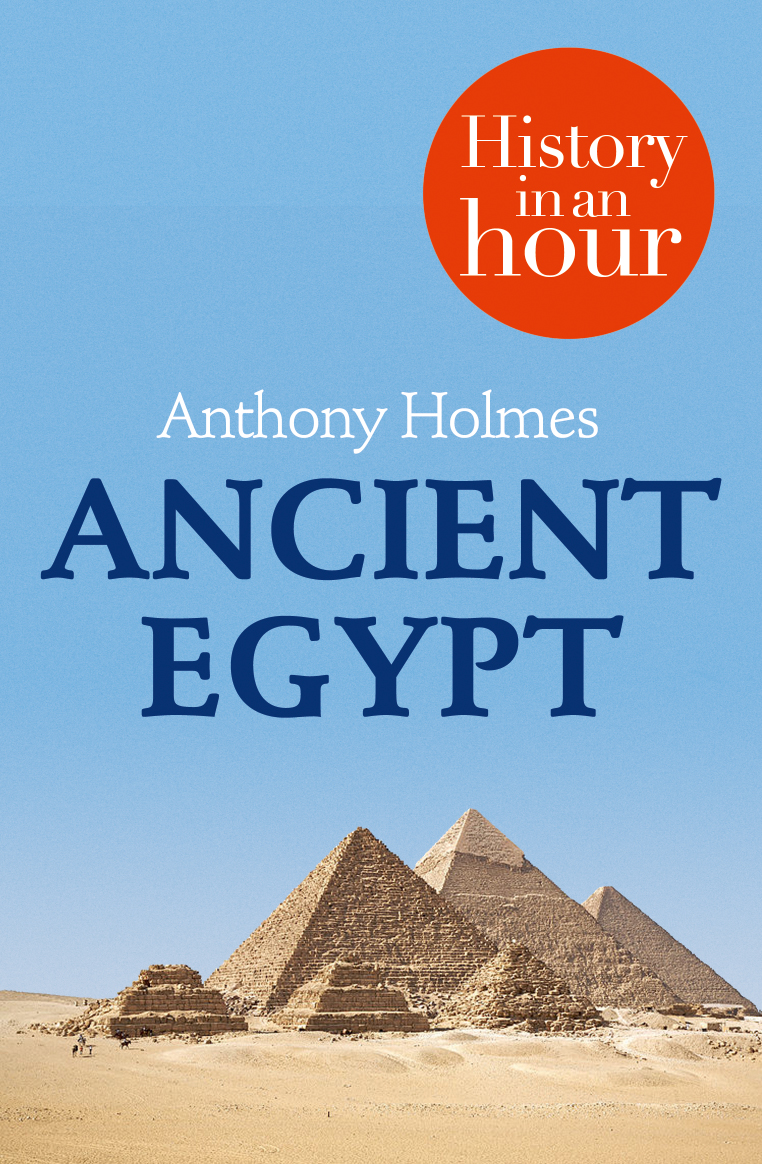
Ancient Egypt
History in an Hour
Anthony Holmes

History in an Hour is a series of ebooks to help the reader learn the basic facts of a given subject area. Everything you need to know is presented in a straightforward narrative and in chronological order. No embedded links to divert your attention, nor a daunting book of 600 pages with a 35-page introduction. Just straight in, to the point, sixty minutes, done. Then, having absorbed the basics, you may feel inspired to explore further.
Give yourself sixty minutes and see what you can learn
To find out more visit: http://historyinanhour.com or follow us on twitter: http://twitter.com/historyinanhour
Contents
The history and mystery of ancient Egypt stirs our imagination and stimulates our desire to understand more about the most influential civilization of the pre-Christian era. The ancient Egyptians preserved their dead in decorated tombs and built magnificent monuments, while other nascent cultures still dressed in skins and lived in rudimentary dwellings. They built in stone, and their choice of construction material has been a boon to those who have tried to unravel the 3,000-year history of their civilization. Painted and inscribed rock-cut tombs, sandstone temples and granite statues have provided us with a comprehensive understanding of their life and culture.
The Egyptians believed in strange animal-headed gods; they mummified their dead in preparation for their journey into the afterlife; they built imposing and enduring stone structures using only Bronze Age tools and their country remained virtually inviolate, unconquered and unchanged for over more than three millennia.
Where did they come from? How did they achieve and maintain a cohesive cultural identity over all that time? What secrets have already been discovered by archaeologists and what revelations might still be waiting to be found hidden in the desert sands of Egypt? Finally, what legacy did they leave to us as we enter the third millennium AD?
This, in an hour, is Ancient Egypt.
Egypt is the gift of the Nile wrote the Greek historian Herodotus in c.400 BC. The River Nile was much more than a reliable source of water; the annual inundation resulting from melting snow and the rainfall in the highlands of Ethiopia brought with it the life-giving silt and nutrients that created the fertile strip of land along its banks. The Nile was the magnet that drew disparate tribes from the surrounding areas and, with its abundance of fish and water fowl, was also the reason for the consolidation of fragmented tribes into the nation called Egypt.
From c.4000 BC to the present day, the inhabited regions of Egypt have been restricted to areas of arable land plus some coastal towns and isolated oases in the Sahara Desert. The populated land is divided into two main areas. The first is the triangular delta region to the north where the Nile splits into branches and eventually flows into the Mediterranean Sea. The second area is the region to the south of the delta along the Nile to Egypts southern border with Sudan.
The Nile flows from south to north. To journey upstream means to travel south, consequently the delta region to the north was called Lower Egypt. The region to the south, along the upper reaches of the Nile, was called Upper Egypt. In our modern convention of drawing maps with north at the top of the page, these names might seem back to front.
Once a society was established along its banks, the Egyptians used the Nile as their main artery for transport. Ships used the rivers strong current to voyage from south to north. On the return voyage, they hoisted a sail to capture the prevailing wind from the north and augmented their progress with oars to propel the vessels upstream to the south.
Egypt was not always as dry as it is now. Archaeological evidence revealed the existence of human habitation in south-west Egypt as early as c.8000 BC. During that period, the Egyptian climate was far wetter than it is today. Dramatic climate change around 8000 BC saw the gradual desertification of the grasslands and the formation of the Sahara Desert.
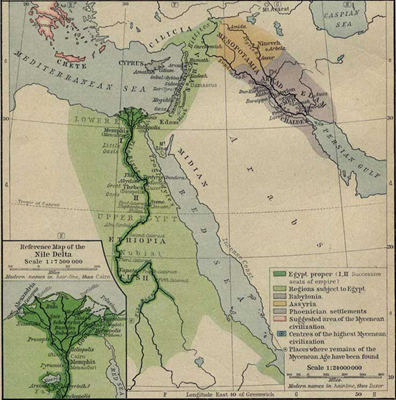
Ancient Egypt
The climate change that dried out western Egypt resulted in the rain moving eastwards. Tribes from the desiccated grasslands moved to the Nile valley and the delta, to take advantage of the seasonal flood of the Nile. The staple foods were already established as wheat and barley, with flax providing the raw material for fabric and rope production.
By c.6000 BC, Egyptians in the south-west were herding cattle and constructing buildings. Permanent settlements existed in c.5500 BC, when inhabitants focused on cereal growing and animal herding. Archaeologists have unearthed burial goods such as metal items, woven baskets, tanned animal hides, hunting tools and woven fabrics dated to c.5000 BC. The dead were buried facing west towards Libya, perhaps looking to their original homeland, and the concept that the western bank of the Nile was the realm of the dead was to remain a feature of Egyptian culture and was a belief that gave rise in modern times to the phrase gone west.
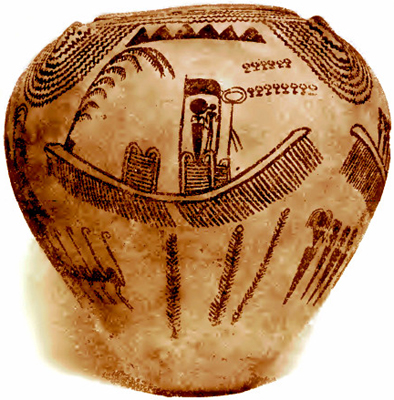
Naqada pottery
Artefacts from the period 5200 BC to 4000 BC discovered at Fayoum Oasis included stone axes, dolerite mace heads, arrowheads, stone palettes, pots, cups and stone beads. Furniture, tableware, decorated pots, combs made from bone and figurines all appeared around this time. Foreign artefacts relating to this period indicate contacts as distant as Lebanon and Syria.
The Naqada culture, named after the town of Nubt, meaning city of gold, commenced c.4000 BC and continued to c.3200 BC, a left pottery decorated with recognizable human and animal shapes. Potters made models of houses which were included in burial goods. Designs on pottery depicting humans and animals became more realistic by c.4000 BC, and techniques of stonework were developed. Tomb building, including the construction of underground storerooms, appeared in the second phase of the Naqada. The burial practices are recognizable as the early Osiris cult of ancient Egypt, and the decorations on the pottery resembled hieroglyphs.
From c.4000 BC to c.3100 BC the Egyptian population was fragmented and comprised various tribes living in Lower and Upper Egypt. As the population increased and the desert encroached, so did the peoples need to expand their access to water and land. Tribal warfare would have been commonplace, although inter-tribal trading between the north and the south was also evident.
Centres of power developed in small autonomous political entities in Lower Egypt and at two centres in Upper Egypt, specifically at Nubt (Naqada) and Nekhen (Hierakonpolis). This somewhat chaotic situation was about to change, with the establishment of what is called Dynasty 0 (zero).
The consolidation of Upper and Lower Egypt under a single centre of rule took place in c.3100 BC. This time of unification is generally recognized as the beginning of ancient Egyptian civilization. The actual dynamics are uncertain, but the name of King Narmer is preeminent. He is generally recognized as the first king of a unified Upper and Lower Egypt.
Next pageFont size:
Interval:
Bookmark:
Similar books «Ancient Egypt: History in an Hour»
Look at similar books to Ancient Egypt: History in an Hour. We have selected literature similar in name and meaning in the hope of providing readers with more options to find new, interesting, not yet read works.
Discussion, reviews of the book Ancient Egypt: History in an Hour and just readers' own opinions. Leave your comments, write what you think about the work, its meaning or the main characters. Specify what exactly you liked and what you didn't like, and why you think so.

